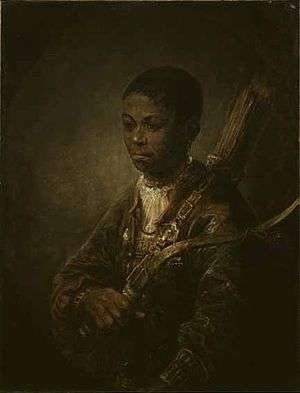A Young Archer
 | |
| Artist | Govaert Flinck |
|---|---|
| Year | c. 1639–1640 |
| Medium | Oil on oak panel |
| Dimensions | 66.2 cm × 50.8 cm (26.1 in × 20.0 in) |
| Location | Wallace Collection |
A Young Archer is an oil painting, painted about 1640 by the Dutch Golden Age artist Govaert Flinck. The painting depicts a young black boy dressed as an archer.[1] The painting is in the collection of the Wallace Collection, in London, England.[1]
Attribution
For many years the painting was believed to have been the work of Rembrandt, and was purchased as such by Richard Seymour-Conway, 4th Marquess of Hertford, in 1848.[1] Flinck had studied under Rembrandt in 1631-32, and his style had become so closely associated with him that for many years a self portrait by Flinck in the National Gallery, London, was thought to have been a portrait of Rembrandt.[2] Flinck painted numerous works in the style of Rembrandt when there was a demand for his work in the 1630s and 1640s.[3] The true origin of the painting was discovered after it was cleaned in 1913, and the signature believed to be by Rembrandt turned out to have been falsely added later.[3] A signature beginning with the letter "f" was discovered.[3] The painting had been reattributed to Flinck by 1928.[3]
Description
An inscription below a print from a drawing of the model suggests that the painting may be modelled after ancient bowmen from Nubia in Eastern Africa.[1] The style of the painting is known as a "tronie", meaning "a head, a face, or expression". Tronies were not portraits of named people but character studies of exotic figures.[2]
This painting was documented by Hofstede de Groot in 1915, who wrote:[4]
- 267. A YOUNG NEGRO ARCHER. Bode 234; Dut. 376; Wb. 253; B.-HdG. 148 -- He stands, turned to the left and looking in that direction. He is about twenty years of age, and has protruding lips and short hair in small curls. He holds a bow at his breast with his right hand. The quiver hangs over his shoulder by a rich gold chain. There are large pearls in his ears and a narrow gold chain round his neck. He has a loose brownish-green coat over a fine pleated shirt, adorned below with a gold chain having large pearls as pendants. Full light falls from the left across the face and on the white shirt. Light grey background. In a painted oval frame. Life size, half-length. Painted about 1634.
- Traces of a signature occur below the bow to the right; oak panel, 26 inches by 20 inches.
- Mentioned by Dutuit, p.48 ; by Michel, pp. 152, 158 [116, 434] ; [by D. S. MacColl, Burlington Magazine, April 1913, No. cxxi. pp. 36-37, contesting the authenticity].
- Exhibited at Bethnal Green Museum, London, 1872, No. 172 ; at the Royal Academy Winter Exhibition, London, 1889, No. 153.
- Possibly identical with "A Moor" occurring in the inventory of the effects of the Amsterdam dealer Johannes de Renialme, June 27, 1657, No. 300 (valued at 12 florins) ; see Hofstede de Groot, Urkunden über Rembrandt, No. 177.
- Sales—(Possibly), London, 1772 (Ľ5 : 17 : 6, Marquess of Carnarvon).
- Duke of Buckingham, Stowe, August 15, 1848, No. 410 (Ľ263 : I I S., S. M. Mawson, for Lord Hertford).
- In the collection of the Marquess of Hertford, London.
- In the Wallace Collection, London, 1913 catalogue, No. 238.
Identity of sitter

Rembrandt also portrayed people of African origin, including black soldiers and figures in armour.[2] It is not known whether the boy was a model, in the army, or a huntsman of a Dutch country estate.[2] Flinck's model was probably a slave, and would have been one of the first slaves to arrive in 17th-century Holland, possibly from Ghana, where the Dutch had a slave trading post in Elmina.[3] Art critic Andrew Graham-Dixon wrote of the subject of A Young Archer in 2004 that
Whether the young man painted by Flinck was actually from the Sudan, or not, it seems likely that the painter intended to show him as a living embodiment of the proud, martial spirit of the Nubian race – a poignant contrast to his actual situation, as a first-generation African slave...The solemn, thoughtful humanity of Flinck's portrayal makes it unusual, among early Western European depictions of black Africans, suggesting at the very least a bond between the artist and the sitter.[3]
References
- 1 2 3 4 "Treasure of the Month". Wallace Collection. Retrieved 18 March 2014.
- 1 2 3 4 Jones, Jonathan (19 May 2001). "Young Archer, Govaert Flinck (c1639-40)". The Guardian. Retrieved 26 March 2014.
- 1 2 3 4 5 6 Graham-Dixon, Andrew (17 October 2004). "ITP 233: A Young Archer by Govaert Flinck". Sunday Telegraph. Retrieved 23 March 2014.
- ↑ Entry 262 for 'A Young Negro Archer' in Hofstede de Groot, 1915